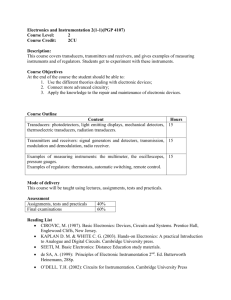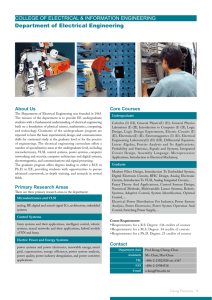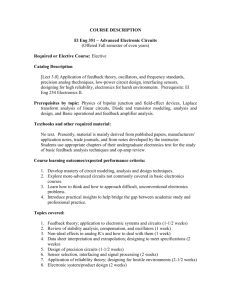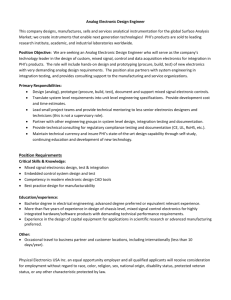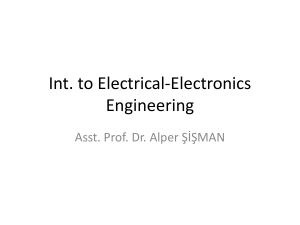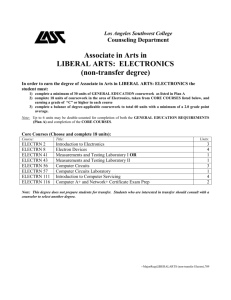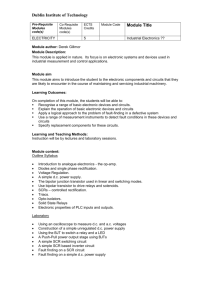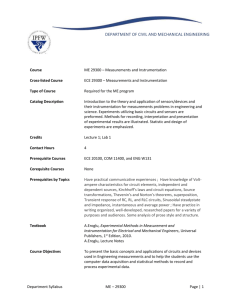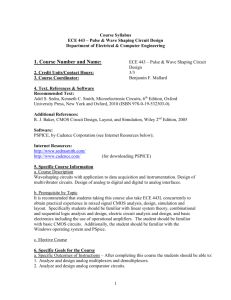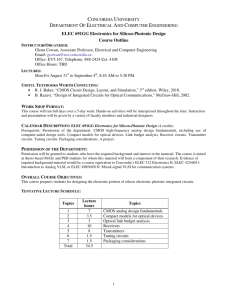ENGR-4300_EI_Syllabus
advertisement
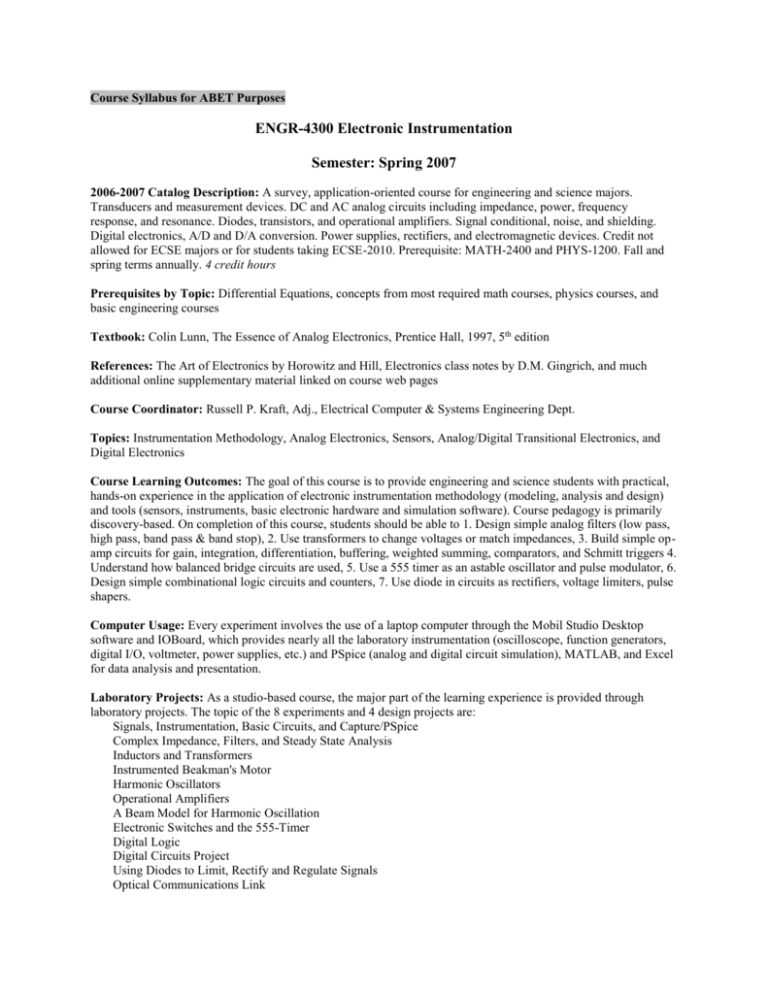
Course Syllabus for ABET Purposes ENGR-4300 Electronic Instrumentation Semester: Spring 2007 2006-2007 Catalog Description: A survey, application-oriented course for engineering and science majors. Transducers and measurement devices. DC and AC analog circuits including impedance, power, frequency response, and resonance. Diodes, transistors, and operational amplifiers. Signal conditional, noise, and shielding. Digital electronics, A/D and D/A conversion. Power supplies, rectifiers, and electromagnetic devices. Credit not allowed for ECSE majors or for students taking ECSE-2010. Prerequisite: MATH-2400 and PHYS-1200. Fall and spring terms annually. 4 credit hours Prerequisites by Topic: Differential Equations, concepts from most required math courses, physics courses, and basic engineering courses Textbook: Colin Lunn, The Essence of Analog Electronics, Prentice Hall, 1997, 5th edition References: The Art of Electronics by Horowitz and Hill, Electronics class notes by D.M. Gingrich, and much additional online supplementary material linked on course web pages Course Coordinator: Russell P. Kraft, Adj., Electrical Computer & Systems Engineering Dept. Topics: Instrumentation Methodology, Analog Electronics, Sensors, Analog/Digital Transitional Electronics, and Digital Electronics Course Learning Outcomes: The goal of this course is to provide engineering and science students with practical, hands-on experience in the application of electronic instrumentation methodology (modeling, analysis and design) and tools (sensors, instruments, basic electronic hardware and simulation software). Course pedagogy is primarily discovery-based. On completion of this course, students should be able to 1. Design simple analog filters (low pass, high pass, band pass & band stop), 2. Use transformers to change voltages or match impedances, 3. Build simple opamp circuits for gain, integration, differentiation, buffering, weighted summing, comparators, and Schmitt triggers 4. Understand how balanced bridge circuits are used, 5. Use a 555 timer as an astable oscillator and pulse modulator, 6. Design simple combinational logic circuits and counters, 7. Use diode in circuits as rectifiers, voltage limiters, pulse shapers. Computer Usage: Every experiment involves the use of a laptop computer through the Mobil Studio Desktop software and IOBoard, which provides nearly all the laboratory instrumentation (oscilloscope, function generators, digital I/O, voltmeter, power supplies, etc.) and PSpice (analog and digital circuit simulation), MATLAB, and Excel for data analysis and presentation. Laboratory Projects: As a studio-based course, the major part of the learning experience is provided through laboratory projects. The topic of the 8 experiments and 4 design projects are: Signals, Instrumentation, Basic Circuits, and Capture/PSpice Complex Impedance, Filters, and Steady State Analysis Inductors and Transformers Instrumented Beakman's Motor Harmonic Oscillators Operational Amplifiers A Beam Model for Harmonic Oscillation Electronic Switches and the 555-Timer Digital Logic Digital Circuits Project Using Diodes to Limit, Rectify and Regulate Signals Optical Communications Link ABET Outcomes Supported: (N = none, M = moderate, H = high) The nature of the experiments and projects emphasize the correlation of measured results to simulation and mathematical modeling. Familiarity with laboratory instrumentation is required to obtain the measurements and good mathematical skills are needed to set up equations modeling the physical characteristics of the systems. ( H ) 3.a an ability to apply knowledge of mathematics, science, and engineering ( H ) 3.b an ability to design and conduct experiments, as well as to analyze and interpret data ( N ) 3.c an ability to design a system, component, or process to meet desired needs within realistic constraints such as economic, environmental, social, political, ethical, health and safety, manufacturability, and sustainability ( N ) 3.d an ability to function on multi-disciplinary teams ( H ) 3.e an ability to identify, formulate, and solve engineering problems ( N ) 3.f an understanding of professional and ethical responsibility ( M) 3.g an ability to communicate effectively (M) 3.h the broad education necessary to understand the impact of engineering solutions in a global, economic, environmental, and societal context ( N ) 3.i a recognition of the need for, and an ability to engage in life-long learning ( N ) 3.j a knowledge of contemporary issues (M) 3.k an ability to use the techniques, skills, and modern engineering tools necessary for engineering practice. Estimated ABET Category Content: Math & Basic Sciences Engineering Topics ½ 3½ Check if contains design ( ) credit hour(s) - ____ % credit hour(s) - ____ % Credit should be in ½ or whole credit amounts. Four of the experiments are more involved than the remaining eight and involve more analysis and design in their completion. These design solutions include designing optimized filters, integrating or differentiating circuits, and some trial-and-error improvements in systems. A thorough analysis of the system being modified is required in order to be able to add functional design enhancements. Prepared by: Russell P. Kraft Date: Feb. 27, 2007 . ABET Outcomes Criterion 3 Outcomes 3(a) an ability to apply knowledge of mathematics, science, and engineering 3(b) an ability to design and conduct experiments, as well as to analyze and interpret data 3(c) an ability to design a system, component, or process to meet desired needs within realistic constraints such as economic, environmental, social, political, ethical, health and safety, manufacturability, and sustainability 3(d) an ability to function on multi-disciplinary teams 3(e) an ability to identify, formulate, and solve engineering problems 3(f) an understanding of professional and ethical responsibility 3(g) an ability to communicate effectively 3(h) the broad education necessary to understand the impact of engineering solutions in a global, economic, environmental, and societal context 3(i) a recognition of the need for, and an ability to engage in life-long learning 3(j) a knowledge of contemporary issues 3(k) an ability to use the techniques, skills, and modern engineering tools necessary for engineering practice.
